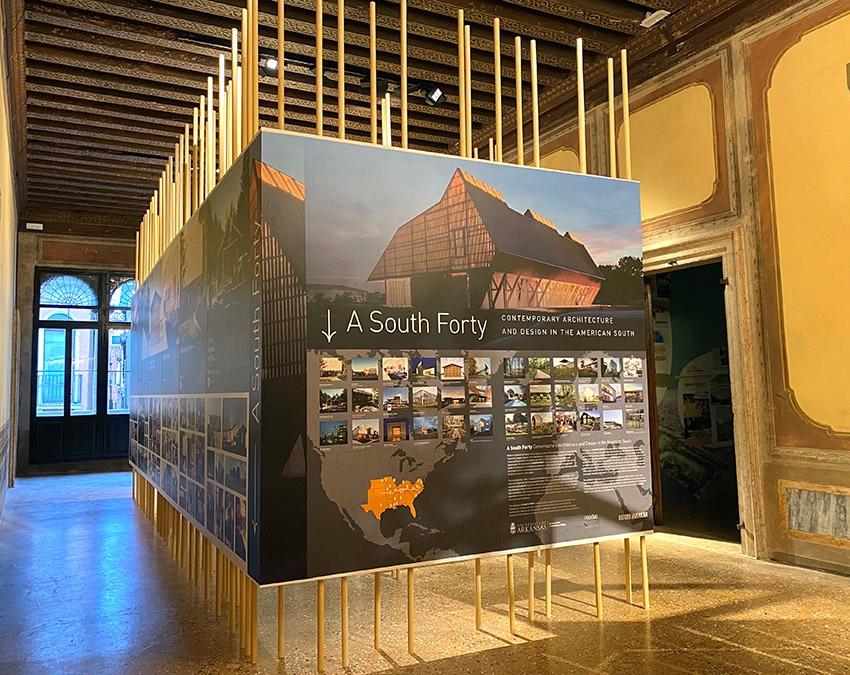
The Fay Jones School of Architecture and Design at the U of A, working with modus studio of Fayetteville, has organized and curated a new exhibition devoted to the vibrant, distinctive contemporary architecture and design practices of the American South.
The exhibition, "A South Forty: Contemporary Architecture and Design in the American South," is installed to coincide with the 2021 Venice Architecture Biennale. It will be on display through Nov. 21 in a collateral venue, the Palazzo Mora of the European Cultural Center in Venice, Italy.
There are nearly 40 practices featured in this exhibition, including five led by Fay Jones School faculty: Marlon Blackwell Architects, SILO AR+D, Somewhere Studio, the U of A Community Design Center and the U of A Urban Design Build Studio.
"The 'story' of A South Forty is one of place-based design, attentive to the necessities of climate, materials, labor and purpose, but also attentive to typologies, constituencies and locales that are overlooked or undervalued," said Peter MacKeith, dean of the Fay Jones School, who together with assistant professor Jonathan Boelkins, organized, curated and designed the exhibition. "While there is the surge of new urban centers and suburban peripheries as conditions to address in the region, there also is a new appreciation for the smaller communities and rural or even wilderness landscapes as productive sites for distinctive work. As well, while design excellence has been achieved by many practices at the residential scale, the greater emphasis in the exhibition is to be seen at the public scale, in the civic realm, through the accomplishment of buildings and projects of strength, durability and value for the communities in which they are situated."
In partnership with the Oxford American, the highly regarded quarterly literary magazine, "A South Forty" will also be featured in the magazine's annual summer issue, which is focused on the idea of "place" within the culture of the American South. The exhibition takes its cues from the critically successful and popularly appealing annual Oxford American issue highlighting the music of the American South and proposes that architecture and design (the built environment) are as reflective and definitive of the culture and values of society as the forms of music that animate that society.
Modern architectural history in the regional context of the American South is conventionally framed by singular figures, from Paul Rudolph and the Sarasota School in Florida to Fay Jones and Bruce Goff in the Ozarks and Oklahoma, or stereotypical typologies and appearances. In counterpoint, A South Forty aims to provide an overview of the current vitality of contemporary architecture and design in the American South, through both illustrated profiles of buildings and practices, and statements of principles and observations by those in practice in the region.
The contemporary "story" centers on the development of architecture and design in the American South over the last generation (from 1990 forward) as the region undergoes rapid economic and population growth, withstands and recovers from multiple natural disasters, and discovers a more complex and diverse identity amidst the historical societal traditions and conventions. Such a mapping of the American South in these terms opens new and essential territories for work in architecture — more positive, empowering, engaged, sensitive and aware work altogether.
"The exhibition implicitly proposes that the path toward that better 'place' of the region leads through both recognition of a common inheritance embedded in the landscape of the American South, and a reconciliation with that physical, cultural and phenomenal landscape," MacKeith said. "There is much work accomplished, but much still to be done, and as a project, A South Forty is just beginning, and still becoming."
The mapping of A South Forty geographically is organized along the armature of Interstate 40, running west from the North Carolina Atlantic seacoast through the southeastern states to an inflection point in Oklahoma. Approximately 40 participating practices in the exhibition are drawn from the larger southeastern region along this latitude.
A South Forty also features the design work of the following practices: Alterstudio Architecture; archimania; ARCHITECTUREFIRM; Dake Wells Architecture; de leon & primmer architecture workshop; DEMX Architecture; Duvall Decker; Ecological Design Group; El Dorado / KSU Design + Make Studio; emerymcclure architecture; EskewDumezRipple; Evoke Studio Architecture; Frank Harmon Architect; Fultz & Singh Architects; Helix Architecture + Design; Hobgood Architects; Ray Huff Architect; Hufft; in situ studio; Katherine Hogan Architects; modus studio; Office of Jonathan Tate; patterhn ives; Pendulum Studio; Polk Stanley Wilcox Architects; Rural Studio, Auburn University; Sanders Pace Architecture; The Raleigh Architecture Company; unabridged Architecture; Vines Architecture; and W.G. Clark Architect.
Last summer, the Fay Jones School partnered with the Oxford American to be the presenting sponsor of its 2020 Summer/Fall double issue, "The Place Issue." As part of the sponsorship, Dean MacKeith authored an essay that appeared in the first pages of that issue, titled "A South Forty: Architecture and Place in the American South."
Contacts
Michelle Parks, director of communications
Fay Jones School of Architecture and Design
479-575-4704, mparks17@uark.edu